Review Summary
We give Taste of the Wild cat food a rating of 4.3 out of 5 stars.
Taste of the Wild is a brand of Diamond Pet Food, which is a pet food company based in the USA. All of its foods are manufactured in the USA and are billed as being affordable and using high-quality ingredients. As well as using real meat, fish, or fowl as their primary ingredient, the brand’s recipes also include unique proteins from boar, bison, duck, trout, and venison.
Although the foods are manufactured in the USA, Diamond sources its ingredients from countries including Belgium and China. Through their Prey range, they also offer limited-ingredient food, which is suited to cats with sensitive stomachs who are intolerant to certain foods. As well as dry foods, Taste of the Wild produces canned wet food. The canned food uses many of the same ingredients as the dry food but is better suited to cats that can’t stomach all dry ingredients.
Taste of the Wild’s concentration of meat, its use of novel proteins, and its grain-free recipes make it appeal to most felines. It’s made all the more palatable by an affordable price tag. However, their ingredients feature some low-cost fillers, and their foods are high in carbs.
At a Glance: The Best Taste of the Wild Cat Food Recipes:
| Image | Product | Details | |
|---|---|---|---|
Our Favorite

|
Taste of the Wild Rocky Mountain |
|
CHECK PRICE |

|
Taste of the Wild High Protein Lowland Creek |
|
CHECK PRICE |

|
Taste of the Wild Rocky Mountain Feline Formula Canned |
|
CHECK PRICE |

|
Taste of the Wild Canyon River Feline Formula Canned |
|
CHECK PRICE |
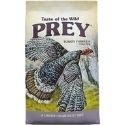
|
Taste of the Wild PREY Real Meat High Protein |
|
CHECK PRICE |
Taste of the Wild Cat Food Reviewed
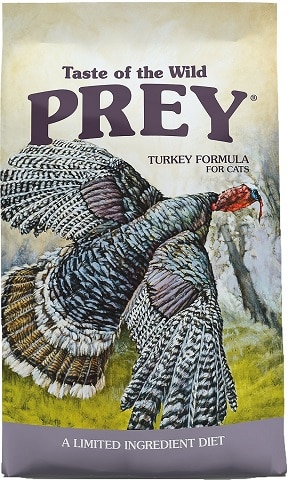
Who Makes Taste of the Wild and Where is it Produced?
Taste of the Wild is a pet food brand manufactured by Diamond Pet Food. The US-based company was founded in 1970 by Gary Schell and Richard Kampeter. They make several lines of pet food. As well as the Taste of the Wild ranges, you will also find Diamond, Diamond Naturals, Diamond Care, and Diamond Pro89, as well as Nutra and NutraNuggets.
Diamond Pet Foods has five manufacturing facilities, all in the US. The plants are in Missouri, South Carolina, Arkansas, and California. All facilities are audited annually by the National Sanitation Foundation International to ensure quality control and safety.
Which Types of Cats is Taste of the Wild Best Suited For?
Taste of the Wild has a varied range of foods. This includes cat foods for indoor and active cats. All their foods are grain-free, which means they are suitable for cats with sensitive stomachs caused by food sensitivities and intolerances.
Which Types of Cats Might Do Better with a Different Brand?
Although the manufacturer claims several ranges are suitable for kittens and seniors because they are formulated for cats of all ages, Taste of the Wild does not offer stage-of-life foods. Cats have different dietary requirements at different stages of their life. Kitten owners, especially, can benefit from giving their pets something easier to chew, digest, and keep down.
Similarly, aging cats have different requirements than kittens. Aging cats may suffer from sensitive or decaying teeth, while many senior cats need to increase their caloric intake because they are less able to benefit from the calories they eat.
What’s In Taste of the Wild Cat Foods?
Taste of the Wild produces several cat foods, and each has unique ingredients. However, following an analysis of the different recipes, the following aspects were found to be present in many of the formulas:
- Grain-Free Recipes – It is generally recommended that cats do not need grain. Grains like corn are often used to bind the other ingredients in pet food formulas. When corn isn’t used, another ingredient must be used instead. Wet food naturally binds together, but dry food will use a starchy replacement as a binder. It is vital to make sure that the binding ingredient is not harmful. Because Taste of the Wild uses grain-free recipes, it is suitable for cats with allergies or those sensitive to these ingredients.
- Meat Primary Ingredients – Taste of the Wild promises that every cat food it makes uses meat or fish as its primary ingredient.
- Pea Protein – Pea protein is found in some Taste of the Wild recipes. It is considered a poor-quality and low-cost filler. It has a lower biological value than meat-based protein but increases the protein ratio for the food. However, pea protein is not harmful or toxic to cats.
- Canola Oil – Canola oil is an oil that is found in some cat foods and is present in Wild Canyon River Feline Recipe Taste of the Wild cat food. This ingredient is used as a fat source and is considered better quality than other plant fats. However, canola oil is usually produced from genetically modified rapeseed oil. The effects of genetically modified ingredients are largely unknown, but many owners prefer to avoid these ingredients.
Prey Limited Ingredient Range
Taste of the Wild manufactures a range of food called Prey. This is a limited ingredient range, and each formula contains no more than four primary ingredients. The first ingredient is the meat source, either Angus beef or turkey. The other main ingredients are lentils and sunflower oil.
You will also find the probiotics and vitamin supplements that are found in other Taste of the Wild recipes, but because there are fewer ingredients, this range is considered better suited to cats that have sensitive stomachs. Prey also has fewer carbohydrates than the other ranges.
Taste of the Wild’s Probiotics
Probiotics are an essential part of a cat’s diet. Taste of the Wild adds its own Viables probiotics blend to its food. These have been developed specifically for cats and are added after the cooking process is complete. This ensures that your cat receives all of the biological benefits of these ingredients. Benefits include an improved immune system, gut health, and general health.
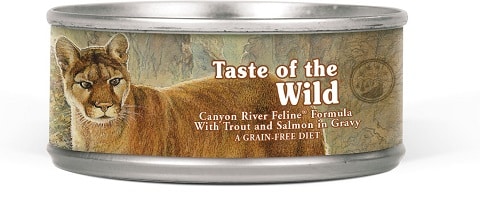
Dry Food and Wet Food Options
Taste of the Wild produces dry food and wet food. They advise you to choose wet food if your cat does not get enough water or moisture in their diet. It contains substantially more water than dry kibble, and because cats love the flavor of wet food, it is a convenient way to ensure they are well-hydrated.
On the other hand, dry food is better for cats that space their meal out over an hour or longer. Kibble does not spoil quickly, so your cat can take a bite whenever they want. It’s also much easier to clean up. You can also feed a combination of dry and wet food over the day, but you need to consider the total calories and nutritional content of each food source to ensure that you are not overfeeding your cat.
If it’s kibble, wet, or a combination of both that your cat enjoys, choosing the right cat bowl to serve it in goes far beyond presentation. Your cat's comfort is at the forefront with the Hepper NomNom Cat Bowl! The unique design benefits cats in many ways - dual stainless steel bowls are shallow and wide to aid with whisker fatigue and slight elevation for proper posture. The wide catch tray ensures that all food (and water!) stays exactly where you’d expect it to be - inside of the bowl! Click here to learn more. At Catster, we’ve admired Hepper for many years and decided to take a controlling ownership interest so that we could benefit from the outstanding designs of this cool cat company!
High In Carbohydrates
Some of the dry and wet cat foods in the Taste of the Wild’s range have higher than necessary carbs. Wild cats would have eaten prey containing minimal carbohydrates. The domestic cat still has a low carbohydrate requirement, and it is believed that a diet that is too high in carbs could be detrimental to your cat’s health.
Too many carbohydrates can lead to obesity and diabetes according to some studies. If your cat suffers from diabetes mellitus, it is recommended that you feed a low-carbohydrate meal.
A Quick Look at Taste of the Wild Cat Food
- Meat is the primary ingredient across all ranges
- Includes Viables probiotics
- Good selection of dry and wet food
- Grain-free formulae
- Inexpensive
- High in carbs
- Use pea protein
- Canola oil is found in one recipe
Taste of Wild Recall History
Diamond and Taste of the Wild have had several recall notices for their food, including cat food ranges. Diamond cat food was recalled in 2005 due to a potential aflatoxin mold contamination, twice in 2012 for potential salmonella contamination, and in 2013 due to a low level of thiamine in their food.
To see all cat food recalls, check out our recall page!
Reviews of the 3 Best Taste of the Wild Cat Food Recipes
1. Taste of the Wild Rocky Mountain Cat Food

With chicken meal as its primary ingredient, Taste of the Wild Rocky Mountain cat food contains 42% protein. Other meat ingredients found in this formula include roasted venison, smoked salmon, and ocean fish meal. The recipe includes Taste of the Wild’s formulated probiotics and a host of other vitamins and minerals that ensure your cat’s nutritional requirements are met.
Pea and potato protein is found in this food, which are considered to have lower biological value than meat protein. They increase the protein count for the food, but the protein is not considered beneficial because it contains fewer other nutrients. As with all Taste of the Wild recipes, Rocky Mountain is a grain-free formula with no artificial ingredients.
Calorie Breakdown:
- Contains Viable probiotics
- Includes several meat proteins
- Inexpensive
- High in carbs
- Contains pea and potato protein
2. Taste of the Wild Canyon River Grain-Free Dry Cat Food
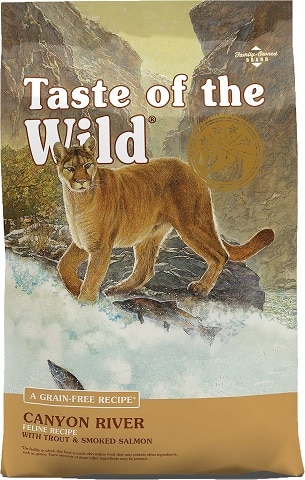
Cats should not be fed a regular diet of pure fish. However, cat food containing fish is considered safe as it has additional thiamine as part of the recipe. Thiamine, or vitamin B1, is an essential nutrient for cats but is not found in large enough quantities. Taste of the Wild Canyon River Grain-Free Dry Cat Food is a grain-free recipe that lists trout and ocean fish meal as its primary ingredients.
It also has added thiamine mononitrate to help prevent a vitamin B1 deficiency in your cat. At 32% protein, this formula has a slightly lower ratio than the Rocky Mountain range but still has a high level of carbs, making up 41% of the dry ingredients.
Calorie Breakdown:
- Primary ingredients of trout and fish meal
- Added thiamine
- Includes Taste of the Wild’s probiotic supplements
- High carb content
3. Taste of the Wild Rocky Mountain Wet Cat Food
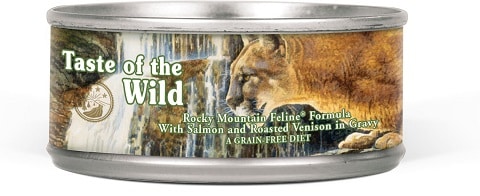
The fish-based Rock Mountain canned food combines salmon, smoked salmon, and ocean fish with chicken liver, chicken, and roasted venison meat sources. It also contains potato starch, peas, and several other ingredients that give it a 32% carbohydrate concentration when dry.
It has a low 8% protein content, but most of it comes from animal sources. The food sticks to Taste of the Wild’s ethos that they use natural ingredients and that their recipes use meat as their primary ingredients while being grain-free.
Calorie Breakdown:
- Meat as the main ingredients
- Wet food is a good source of moisture
- Natural ingredients
- High in carbohydrates
What Other Users Are Saying
Here’s what others are saying about Taste of the Wild’s cat food range.
- AllAboutCats – “An affordable brand that offers meat-centric, grain-free foods.”
- MyPetNeedsThat – “A cat food brand that has developed a good reputation over the years for its ethos of mimicking the kind of food that your feline would have eaten in the wild.”
- Chewy – Read real buyers’ reviews on Chewy – click here.
Conclusion
Taste of the Wild promises to use natural ingredients and ensure that all of its pet foods use meat or fish as the primary ingredient. They also add vegetables and fruits, as well as their proprietary probiotic mix, ensuring that your cat enjoys a great-tasting and nutritious meal. There is the limited-ingredient Prey range for cats with sensitive stomachs, which has four primary ingredients with vitamins and probiotics added to fortify your cat’s good health.
Thanks to their use of natural ingredients, the lack of artificial colorings, and minimal use of fillers, Taste of the Wild is recognized as a premium food, but it doesn’t carry the same price tag as a lot of competing premium brands. However, the food is a little rich in carbohydrates, and at least one of their ranges includes canola oil, which is a controversial ingredient. Although there haven’t been any in the past few years, Diamond, Taste of the Wild’s parent company, has experienced several product recalls over the years.
Featured Image Credit: Taste of the Wild, Chewy
Contents
- Review Summary
- At a Glance: The Best Taste of the Wild Cat Food Recipes:
- Taste of the Wild Cat Food Reviewed
- Who Makes Taste of the Wild and Where is it Produced?
- Which Types of Cats is Taste of the Wild Best Suited For?
- Which Types of Cats Might Do Better with a Different Brand?
- What’s In Taste of the Wild Cat Foods?
- Prey Limited Ingredient Range
- Taste of the Wild’s Probiotics
- Dry Food and Wet Food Options
- High In Carbohydrates
- A Quick Look at Taste of the Wild Cat Food
- Taste of Wild Recall History
- Reviews of the 3 Best Taste of the Wild Cat Food Recipes
- 1. Taste of the Wild Rocky Mountain Cat Food
- Calorie Breakdown:
- 2. Taste of the Wild Canyon River Grain-Free Dry Cat Food
- Calorie Breakdown:
- 3. Taste of the Wild Rocky Mountain Wet Cat Food
- Calorie Breakdown:
- What Other Users Are Saying
- Conclusion

















